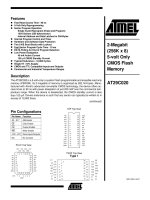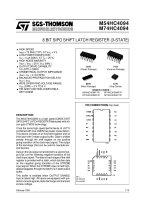Điện tử viễn thông LGW2EChapter3Presentation khotailieu
Bạn đang xem bản rút gọn của tài liệu. Xem và tải ngay bản đầy đủ của tài liệu tại đây (609.05 KB, 163 trang )
Chapter 3
Digital Transmission
Fundamentals
Digital Representation of Information
Why Digital Communications?
Digital Representation of Analog Signals
Characterization of Communication Channels
Fundamental Limits in Digital Transmission
Line Coding
Modems and Digital Modulation
Properties of Media and Digital Transmission Systems
Error Detection and Correction
Digital Networks
z
Digital transmission enables networks to
support many services
TV
E-mail
Telephone
Questions of Interest
z
How long will it take to transmit a message?
z
z
z
Can a network/system handle a voice (video) call?
z
z
How many bits/second does voice/video require? At what
quality?
How long will it take to transmit a message without
errors?
z
z
z
How many bits are in the message (text, image)?
How fast does the network/system transfer information?
How are errors introduced?
How are errors detected and corrected?
What transmission speed is possible over radio,
copper cables, fiber, infrared, …?
Chapter 3
Digital Transmission
Fundamentals
Digital Representation of
Information
Bits, numbers, information
z
Bit: number with value 0 or 1
z
z
z
z
n bits allows enumeration of 2n possibilities
z
z
z
z
n bits: digital representation for 0, 1, … , 2n
Byte or Octet, n = 8
Computer word, n = 16, 32, or 64
n-bit field in a header
n-bit representation of a voice sample
Message consisting of n bits
The number of bits required to represent a message
is a measure of its information content
z
More bits → More content
Block vs. Stream Information
Block
z Information that occurs
in a single block
z
z
z
z
z
Text message
Data file
JPEG image
MPEG file
Size = Bits / block
or bytes/block
z
z
z
1 kbyte = 210 bytes
1 Mbyte = 220 bytes
1 Gbyte = 230 bytes
Stream
z Information that is
produced & transmitted
continuously
z
z
z
Real-time voice
Streaming video
Bit rate = bits / second
z
z
z
1 kbps = 103 bps
1 Mbps = 106 bps
1 Gbps =109 bps
Transmission Delay
z
z
z
z
z
z
L
R bps
L/R
tprop
d
c
number of bits in message
speed of digital transmission system
time to transmit the information
time for signal to propagate across medium
distance in meters
speed of light (3x108 m/s in vacuum)
Delay = tprop + L/R = d/c + L/R seconds
Use data compression to reduce L
Use higher speed modem to increase R
Place server closer to reduce d
Compression
z
z
Information usually not represented efficiently
Data compression algorithms
z
z
Represent the information using fewer bits
Noiseless: original information recovered exactly
z
z
Noisy: recover information approximately
z
z
z
E.g. zip, compress, GIF, fax
JPEG
Tradeoff: # bits vs. quality
Compression Ratio
#bits (original file) / #bits (compressed file)
Color Image
W
H
Color
image = H
W
W
W
Red
component
image
Green
component
image
Blue
component
image
+ H
+ H
Total bits = 3 × H × W pixels × B bits/pixel = 3HWB bits
Example: 8×10 inch picture at 400 × 400 pixels per inch2
400 × 400 × 8 × 10 = 12.8 million pixels
8 bits/pixel/color
12.8 megapixels × 3 bytes/pixel = 38.4 megabytes
Examples of Block Information
Type
Method
Format
Original
Compressed
(Ratio)
Text
Zip,
compress
ASCII
KbytesMbytes
(2-6)
Fax
CCITT
Group 3
A4 page
200x100
pixels/in2
256
kbytes
5-54 kbytes
(5-50)
JPEG
8x10 in2 photo
4002 pixels/in2
38.4
Mbytes
1-8 Mbytes
(5-30)
Color
Image
Stream Information
z
z
A real-time voice signal must be digitized &
transmitted as it is produced
Analog signal level varies continuously in time
Th e s p ee ch s
i
g n al l e
v el
v a r ie s w i th
t
i
m(e)
Digitization of Analog Signal
z
Sample analog signal in time and amplitude
Find closest approximation
Original signal
Sample value
3 bits / sample
z
7Δ/2
5Δ/2
3Δ/2
Δ/2
Approximation
−Δ/2
−3Δ/2
−5Δ/2
−7Δ/2
Rs = Bit rate = # bits/sample x # samples/second
Bit Rate of Digitized Signal
z
Bandwidth Ws Hertz: how fast the signal changes
z
z
z
Higher bandwidth → more frequent samples
Minimum sampling rate = 2 x Ws
Representation accuracy: range of approximation
error
Higher accuracy
→ smaller spacing between approximation values
→ more bits per sample
z
Example: Voice & Audio
Telephone voice
z Ws = 4 kHz → 8000
samples/sec
z 8 bits/sample
z Rs=8 x 8000 = 64 kbps
z
Cellular phones use
more powerful
compression
algorithms: 8-12 kbps
CD Audio
z Ws = 22 kHertz → 44000
samples/sec
z 16 bits/sample
z Rs=16 x 44000= 704 kbps
per audio channel
z MP3 uses more powerful
compression algorithms:
50 kbps per audio
channel
Video Signal
z
Sequence of picture frames
z
z
Frame repetition rate
z
z
Each picture digitized &
compressed
10-30-60 frames/second
depending on quality
Frame resolution
z
z
z
Small frames for
videoconferencing
Standard frames for
conventional broadcast TV
HDTV frames
30 fps
Rate = M bits/pixel x (WxH) pixels/frame x F frames/second
Video Frames
176
QCIF videoconferencing
at 30 frames/sec =
144
760,000 pixels/sec
720
Broadcast TV
480
at 30 frames/sec =
10.4 x 106 pixels/sec
1920
HDTV
at 30 frames/sec =
1080
67 x 106 pixels/sec
Digital Video Signals
Type
Video
Conference
Full
Motion
HDTV
Method
Format
H.261
Original Compressed
176x144 or
352x288 pix
@10-30
fr/sec
MPEG 720x480 pix
2
@30 fr/sec
2-36
Mbps
64-1544
kbps
249
Mbps
2-6 Mbps
MPEG
2
1.6
Gbps
19-38 Mbps
1920x1080
@30 fr/sec
Transmission of Stream
Information
z
Constant bit-rate
z
z
z
Signals such as digitized telephone voice produce
a steady stream: e.g. 64 kbps
Network must support steady transfer of signal,
e.g. 64 kbps circuit
Variable bit-rate
z
z
Signals such as digitized video produce a stream
that varies in bit rate, e.g. according to motion and
detail in a scene
Network must support variable transfer rate of
signal, e.g. packet switching or rate-smoothing
with constant bit-rate circuit
Stream Service Quality Issues
Network Transmission Impairments
z Delay: Is information delivered in timely
fashion?
z Jitter: Is information delivered in sufficiently
smooth fashion?
z Loss: Is information delivered without loss? If
loss occurs, is delivered signal quality
acceptable?
z Applications & application layer protocols
developed to deal with these impairments
Chapter 3
Communication
Networks and Services
Why Digital Communications?
A Transmission System
Transmitter
Receiver
Communication channel
Transmitter
z Converts information into signal suitable for transmission
z Injects energy into communications medium or channel
z
z
Telephone converts voice into electric current
Modem converts bits into tones
Receiver
z Receives energy from medium
z Converts received signal into form suitable for delivery to user
z
z
Telephone converts current into voice
Modem converts tones into bits
Transmission Impairments
Transmitted
Signal
Received
Signal Receiver
Transmitter
Communication channel
Communication Channel
z Pair of copper wires
z Coaxial cable
z Radio
z Light in optical fiber
z Light in air
z Infrared
Transmission Impairments
z Signal attenuation
z Signal distortion
z Spurious noise
z Interference from other
signals
Analog Long-Distance
Communications
Transmission segment
Source
z
z
z
z
z
z
...
Repeater
Destination
Each repeater attempts to restore analog signal to
its original form
Restoration is imperfect
z
z
Repeater
Distortion is not completely eliminated
Noise & interference is only partially removed
Signal quality decreases with # of repeaters
Communications is distance-limited
Still used in analog cable TV systems
Analogy: Copy a song using a cassette recorder
Analog vs. Digital Transmission
Analog transmission: all details must be reproduced accurately
Sent
Distortion
Attenuation Received
Digital transmission: only discrete levels need to be reproduced
Sent
Distortion
Attenuation
Received
Simple Receiver:
Was original
pulse positive or
negative?
Digital Long-Distance
Communications
Transmission segment
Source
z
z
z
z
z
z
Regenerator
...
Regenerator
Destination
Regenerator recovers original data sequence and
retransmits on next segment
Can design so error probability is very small
Then each regeneration is like the first time!
Analogy: copy an MP3 file
Communications is possible over very long distances
Digital systems vs. analog systems
z
z
Less power, longer distances, lower system cost
Monitoring, multiplexing, coding, encryption, protocols…









